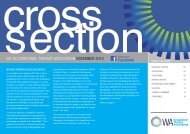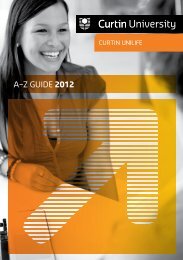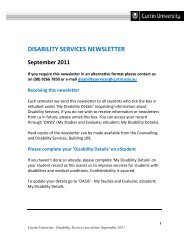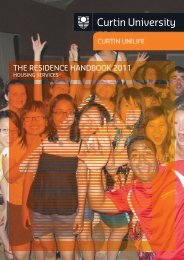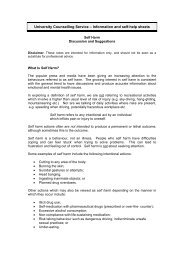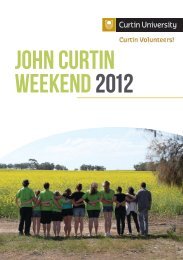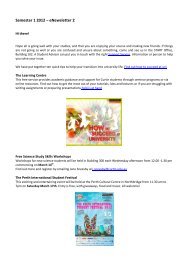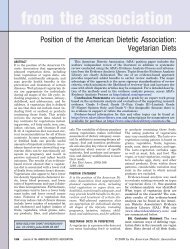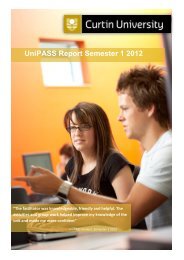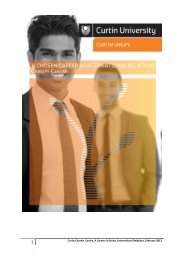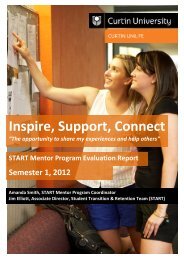Disability Access and Inclusion Plan 2012-2017 - Unilife - Curtin ...
Disability Access and Inclusion Plan 2012-2017 - Unilife - Curtin ...
Disability Access and Inclusion Plan 2012-2017 - Unilife - Curtin ...
You also want an ePaper? Increase the reach of your titles
YUMPU automatically turns print PDFs into web optimized ePapers that Google loves.
disabilityaccess <strong>and</strong><strong>Inclusion</strong> plan<strong>2012</strong>–<strong>2017</strong>
disability access <strong>and</strong> inclusion plan <strong>2012</strong>–<strong>2017</strong> 1from thevice-chancellorIt is with pleasure that I present <strong>Curtin</strong>’s<strong>Disability</strong> <strong>Access</strong> <strong>and</strong> <strong>Inclusion</strong> <strong>Plan</strong><strong>2012</strong>–<strong>2017</strong>.While this is <strong>Curtin</strong>’s second five-year planunder the requirements of the WesternAustralian disability legislation, it is in fact ourthird formal disability plan, having committedourselves to a <strong>Disability</strong> Services <strong>Plan</strong> in 1997when this was not a requirement. We still takepride in being the first WA university to do so.Through each of our plans we have strivedto make <strong>Curtin</strong> a more accessible <strong>and</strong> inclusiveenvironment for people with a disability tosucceed in higher education. We have evolvedfrom the practice of a ‘removing barriers’approach, to a proactive model of sharedresponsibilities <strong>and</strong> inclusive design. In thisplan we intend to use the experience of ourinternationally recognised experts to guideus in best practice trends, to engage in the<strong>Disability</strong> Services Commission’s ‘Count Me In –<strong>Disability</strong> Future Directions’ strategy, <strong>and</strong> toembed the principles of ‘universal design’ –a universalist approach to design <strong>and</strong>processes – more fully in our facilities,academic programs <strong>and</strong> services to ensureaccessibility for the widest range of users.We intend to benchmark ourselves against theworld’s best practices in access <strong>and</strong> inclusionin higher education, <strong>and</strong> we seek to be a leaderin our sector.Our students, staff <strong>and</strong> the WesternAustralian public are our partners in thesegoals <strong>and</strong> we welcome feedback on ourprogress at any time.Professor Jeanette Hacket AMVice-Chancellor<strong>Curtin</strong> University
2 disability access <strong>and</strong> inclusion plan <strong>2012</strong>–<strong>2017</strong>contentsACKNOWLEDGEMENT......................................................................................................................3EXECUTIVE SUMMARY.....................................................................................................................4INTRODUCTION.................................................................................................................................5Who we are......................................................................................................................................................5What we offer..................................................................................................................................................6ABOUT OUR DISABILITY ACCESS AND INCLUSION PLAN............................................................7What is a DAIP?...............................................................................................................................................7What is our DAIP about?................................................................................................................................7Strategic alignment of our DAIP...................................................................................................................8Scope of our DAIP............................................................................................................................................8Responsibility for implementing our DAIP.................................................................................................9Agents <strong>and</strong> contractors...............................................................................................................................10DEVELOPMENT OF OUR DISABILITY ACCESS AND INCLUSION PLAN <strong>2012</strong>–<strong>2017</strong>................. 11The Act’s requirements................................................................................................................................11How was our DAIP developed?....................................................................................................................11Review process..............................................................................................................................................11Consultation process...................................................................................................................................11DAIP 2007–2011 consultation <strong>and</strong> review results..................................................................................12Communicating the DAIP <strong>2012</strong>–<strong>2017</strong>......................................................................................................15KEEPING THE DISABILITY ACCESS AND INCLUSION PLAN <strong>2012</strong>–<strong>2017</strong> FRESH...................... 16Annual Activity <strong>Plan</strong>s...................................................................................................................................16Continual consultation with our students, staff <strong>and</strong> visitors...............................................................16How will our DAIP be reviewed?..................................................................................................................16DISABILITY ACCESS AND INCLUSION PLAN <strong>2012</strong>–<strong>2017</strong> STRATEGIES.................................... 17REFERENCES.................................................................................................................................. 22GLOSSARY OF TERMS.................................................................................................................... 23APPENDIXES................................................................................................................................... 24
disability access <strong>and</strong> inclusion plan <strong>2012</strong>–<strong>2017</strong> 3ACKNOWLEDGEMENT<strong>Curtin</strong> University appreciates the feedbackreceived during the five-year review of our<strong>Disability</strong> <strong>Access</strong> <strong>and</strong> <strong>Inclusion</strong> <strong>Plan</strong> 2007–2011 from our students, staff, <strong>and</strong> individualsin the Western Australian community. Thishas been invaluable in helping us underst<strong>and</strong>our achievements <strong>and</strong> the work we still haveahead, <strong>and</strong> has informed our preparation ofthis <strong>Disability</strong> <strong>Access</strong> <strong>and</strong> <strong>Inclusion</strong> <strong>Plan</strong>.<strong>Curtin</strong> also acknowledges the professionalwork undertaken on its behalf by E-QUAL<strong>Disability</strong> Consultants in reviewing our<strong>Disability</strong> <strong>Access</strong> <strong>and</strong> <strong>Inclusion</strong> <strong>Plan</strong> 2007–2011 <strong>and</strong> in assisting us to formulate ournew plan.
4 disability access <strong>and</strong> inclusion plan <strong>2012</strong>–<strong>2017</strong>executive summary<strong>Curtin</strong> University believes in creatingequitable <strong>and</strong> inclusive access for people witha disability to our facilities, services, events<strong>and</strong> academic programs on all our WesternAustralian campuses. Our <strong>Disability</strong> <strong>Access</strong><strong>and</strong> <strong>Inclusion</strong> <strong>Plan</strong> (DAIP) affords us a valuableopportunity to signal our commitment toincluding people with a disability in our corebusiness. Our DAIP informs our students, staff<strong>and</strong> the public about the areas of access <strong>and</strong>inclusion on all our WA locations that can beimproved, <strong>and</strong> our strategies to address them.It also recognises there are many ways to dothis. Our strategies are designed to help uswork solidly towards achieving our goal ofinclusion <strong>and</strong> access for all.<strong>Curtin</strong> is required by a 2004 amendmentto the <strong>Disability</strong> Services Act 1993 (WA) toprepare <strong>and</strong> lodge a DAIP. The <strong>Disability</strong>Services Commission (DSC) is m<strong>and</strong>atedto receive the plan <strong>and</strong> to require annualreporting in <strong>Curtin</strong>’s Annual Report. <strong>Curtin</strong> isalso required to report to the DSC each Julyon the progress of its plan. A full review of theDAIP must be undertaken every five years.The DAIP supports <strong>Curtin</strong>’s Strategic <strong>Plan</strong>2009–2013 <strong>and</strong> the Teaching <strong>and</strong> LearningEnabling <strong>Plan</strong> 2009–2013, <strong>and</strong> will supportsubsequent strategic plans as they aredeveloped. The intention of the DAIP is toensure people with a disability can accesseducation <strong>and</strong> services in a way that facilitatesindependence, opportunities <strong>and</strong> inclusionat <strong>Curtin</strong>. The six outcomes of the plan havebeen prescribed by the DSC. <strong>Curtin</strong> voluntarilyadded Outcome 7 to include employment ofpeople with a disability at <strong>Curtin</strong> in its2007–2011 DAIP, <strong>and</strong> this is continued inthe new plan.The DAIP will be implemented in AnnualActivity <strong>Plan</strong>s, which have had wide input from<strong>Curtin</strong> staff – in particular, from the <strong>Disability</strong><strong>Access</strong> <strong>and</strong> <strong>Inclusion</strong> <strong>Plan</strong> ImplementationCommittee (DAIPIC).This plan replaces <strong>Curtin</strong>’s 2007–2011DAIP. The strategies identified to achievethe prescribed DAIP outcomes have beendeveloped following a comprehensive review<strong>and</strong> community consultation process involvingstudents, staff <strong>and</strong> visitors, conductedbetween April <strong>and</strong> September 2011.
disability access <strong>and</strong> inclusion plan <strong>2012</strong>–<strong>2017</strong> 5introductionWho we are<strong>Curtin</strong>’s mission:<strong>Curtin</strong> is committed toinnovation <strong>and</strong> excellencein teaching <strong>and</strong> research,for the benefit of ourstudents <strong>and</strong> the widercommunity.Our DAIP commits to innovation <strong>and</strong>excellence in its actions, for the benefit ofour students <strong>and</strong> community; <strong>and</strong> further,makes <strong>Curtin</strong> accessible to people whoseinnovation <strong>and</strong> excellence might otherwisebe denied or lost to the community. It buildson our values of social justice <strong>and</strong> inclusion,<strong>and</strong> equality of opportunity in education<strong>and</strong> employment for all.We are Western Australia’s largest <strong>and</strong> mostculturally diverse university, with more than47,000 students <strong>and</strong> 3,500 staff. Our maincampus is located in Bentley – six kilometressouth of the centre of Perth, WA’s capitalcity. We have two additional metropolitancampuses at Shenton Park <strong>and</strong> in thePerth CBD. We also have a strong commitmentto our regional community, with campuses<strong>and</strong> education centres across WA, including atKalgoorlie <strong>and</strong> Margaret River, <strong>and</strong> at Northamuntil the end of <strong>2012</strong>. Domestically, we alsohave a campus in the Sydney Central BusinessDistrict.<strong>Curtin</strong> has a strong commitment tointernational engagement, maintainingAustralia’s third-largest international studentpopulation. We have offshore campuses inMalaysia <strong>and</strong> Singapore, <strong>and</strong> partnershipswith more than 90 education institutionsworldwide.Our teaching areas include the Centre forAboriginal Studies <strong>and</strong> the following faculties:<strong>Curtin</strong> Business School, Health Sciences,Humanities, <strong>and</strong> Science <strong>and</strong> Engineering.
6 disability access <strong>and</strong> inclusion plan <strong>2012</strong>–<strong>2017</strong>Our values are integrity, respect, fairness <strong>and</strong>care. We foster inclusion <strong>and</strong> encourage thedevelopment of graduates who are equippedwith the knowledge <strong>and</strong> skills required to meetindustry <strong>and</strong> workplace st<strong>and</strong>ards.What we offer<strong>Curtin</strong> offers a wide range of undergraduate<strong>and</strong> postgraduate courses in business,humanities, health sciences, resources,engineering <strong>and</strong> related sciences, <strong>and</strong>Indigenous studies. We’re also recognised forhigh-impact research across four defined <strong>and</strong>distinct areas of focus:• minerals <strong>and</strong> energy• ICT <strong>and</strong> emerging technologies• sustainable development• health.We have close links with business, industry,government <strong>and</strong> the community, <strong>and</strong> ourcourses have a strong practical focus, withmany involving vocational or work experiencecomponents.Teaching <strong>and</strong> learningOur aim is to develop graduates who arelifelong learners <strong>and</strong> who will make a positivecontribution to society.We are widely recognised for the practical <strong>and</strong>applied nature of our courses, which providestudents with essential skills through exposureto industry <strong>and</strong> business. As a result, <strong>Curtin</strong>graduates are job-ready <strong>and</strong> prepared, withskills that enable them to make a genuine <strong>and</strong>positive influence in their chosen fields.ResearchThrough our research, we aspire to findcreative solutions to significant problems.We are committed to contributing to thesustainable social, environmental <strong>and</strong>economic development of Western Australia<strong>and</strong> the broader national <strong>and</strong> internationalcommunity though our strategy of research inpartnership: building world-class capability inresearch <strong>and</strong> development through strategicalliances <strong>and</strong> partnerships.We strive for excellence in our core activitiesof teaching <strong>and</strong> learning <strong>and</strong> research <strong>and</strong>development.
disability access <strong>and</strong> inclusion plan <strong>2012</strong>–<strong>2017</strong> 7ABOUT OUR DISABILITYACCESS AND INCLUSION PLANWhat is a DAIP?<strong>Curtin</strong> is a public authority affected by Part 5of the Western Australian <strong>Disability</strong> ServicesAct 1993 (as amended 2004) (the ‘Act’), whichrequires us to develop <strong>and</strong> implement a DAIPto further the principles <strong>and</strong> objectives of theAct. The principles 1 of the Act apply to howpeople with a disability have the right to berespected <strong>and</strong> treated with dignity, <strong>and</strong> havethe same human rights as other communitymembers – regardless of the degree <strong>and</strong> natureof their disability.What is our DAIP about?We are committed to ensuring equitable <strong>and</strong>inclusive access for people with a disability toour facilities, services, events <strong>and</strong> academicprograms on all our Western Australiancampuses. Our DAIP informs our students,staff <strong>and</strong> the public about the areas of access<strong>and</strong> inclusion on all our WA locations that canbe improved, <strong>and</strong> our strategies to addressthem.These strategies, which are defined in theAct as the minimum st<strong>and</strong>ard for DAIPs <strong>and</strong>are informed by the principles of the Act, worktowards a number of access <strong>and</strong> inclusionoutcomes which underpin our commitmentto our students, staff <strong>and</strong> visitors with adisability.These outcomes provided by the DSC formthe basis of our plan:1. People with disabilities have the sameopportunities as other people to access theservices of, <strong>and</strong> events organised by, <strong>Curtin</strong>.2. People with disabilities have the sameopportunities as other people to access<strong>Curtin</strong>’s buildings <strong>and</strong> facilities.3. People with disabilities receive informationfrom <strong>Curtin</strong> in a format that will enablethem to access the information as readilyas other people are able to access it.4. People with disabilities receive the samelevel <strong>and</strong> quality of service from <strong>Curtin</strong> staffas other people receive from <strong>Curtin</strong> staff.5. People with disabilities have the sameopportunities as other people to makecomplaints to <strong>Curtin</strong>.6. People with disabilities have the sameopportunities as other people to participatein any public consultation by <strong>Curtin</strong>.Five years ago, <strong>Curtin</strong> voluntarily addedanother outcome – <strong>and</strong> it continues in this plan:7. People with disabilities have the sameopportunities as other people to participatein employment at <strong>Curtin</strong>.1 Schedule 1 listed in full at Appendix A
8 disability access <strong>and</strong> inclusion plan <strong>2012</strong>–<strong>2017</strong><strong>Curtin</strong> is actively promoting <strong>and</strong> embeddingthe principles of ‘universal design’ – auniversalist approach to design <strong>and</strong> processes –in its strategies to achieve these outcomes.Note: <strong>Curtin</strong> recognises the <strong>Disability</strong>Discrimination Act 1992 2 (Cwlth) definitionof disability.Strategic alignment of our DAIP<strong>Curtin</strong>’s commitment to equity <strong>and</strong> qualityprograms is a core element in our strategicplanning. This DAIP supports the vision,mission <strong>and</strong> values outlined in <strong>Curtin</strong>’sStrategic <strong>Plan</strong> 2009–2013, namely to:• build on our strengths <strong>and</strong> improve thequality <strong>and</strong> impact of both teaching <strong>and</strong>research• enhance the student experience• engage with our community• develop an organisational culture thatengages our staff• secure our financial position.<strong>Curtin</strong>’s strategic plan ensures our students,staff <strong>and</strong> visitors have equitable access to ourprograms, services <strong>and</strong> facilities. This DAIPalso supports <strong>Curtin</strong>’s Teaching <strong>and</strong> LearningEnabling <strong>Plan</strong> 2009–2013.Furthermore, this DAIP aligns with <strong>Curtin</strong>’spolicies that support diversity, ethics <strong>and</strong>social justice, guiding ethical principles,<strong>and</strong> procedures for the elimination ofdiscrimination <strong>and</strong> harassment.Scope of our DAIPOur DAIP is determined by state legislation<strong>and</strong> applies to our WA campuses. It is alsolodged with the Australian Human RightsCommission to demonstrate our compliancewith the federal <strong>Disability</strong> Discrimination Act1992 <strong>and</strong> its st<strong>and</strong>ards 3 .2 Appendix B3 <strong>Disability</strong> St<strong>and</strong>ards for Education 2005<strong>and</strong> <strong>Disability</strong> (<strong>Access</strong> to Premises – Buildings)St<strong>and</strong>ards 2010
disability access <strong>and</strong> inclusion plan <strong>2012</strong>–<strong>2017</strong> 9This ensures that our access inclusionstrategies apply to all our onshore Australiancampuses, <strong>and</strong> provides the benchmark foraccess <strong>and</strong> inclusion st<strong>and</strong>ards at our offshorecampuses, where a particular country maynot have disability legislation.Responsibility forimplementing our DAIP<strong>Curtin</strong>’s DAIPIC has the responsibility tooversee the implementation of the DAIP <strong>and</strong>to report ultimately to the Academic Board.This committee uses a working party model<strong>and</strong> meets twice a year. Chaired by theDeputy Vice-Chancellor Education, themembership 4 comprises executive <strong>and</strong> seniormanagement staff whose organisationalresponsibilities naturally align with end-lineresponsibilities identified in the DAIP. Membersare supported in this role by <strong>Curtin</strong>’s DAIPImplementation Manager.The role <strong>and</strong> modus oper<strong>and</strong>i of the DAIPICis being reviewed to determine the bestapproach to the rollout of our new DAIP.4 Full list of members at Appendix C
10 disability access <strong>and</strong> inclusion plan <strong>2012</strong>–<strong>2017</strong>Agents <strong>and</strong> contractorsThe Act directs that <strong>Curtin</strong>’s DAIP is alsoimplemented by our agents <strong>and</strong> contractors,with the expectation they provide theirservice in a way that is in keeping with<strong>Curtin</strong>’s access <strong>and</strong> inclusion practices.We are required to inform our agents<strong>and</strong> contractors about our DAIP, <strong>and</strong>request they report their aligned practicesto us on an annual basis. This will beimplemented through the dedicated websiteunilife.curtin.edu.au/health_wellbeing/AgentContractorDAIPActivities.htm <strong>and</strong>through professional development for<strong>Curtin</strong>’s contract managers.All <strong>Curtin</strong> staff, however, are equallyresponsible for the implementation of our DAIPthrough the strategy of embedding inclusivepractices throughout normal business, bothacademic <strong>and</strong> general.Ultimately, the Vice-Chancellor hasfinal responsibility to ensure the DAIP isimplemented.
disability access <strong>and</strong> inclusion plan <strong>2012</strong>–<strong>2017</strong> 11DEVELOPMENT OF OURDISABILITY ACCESS ANDINCLUSION PLAN <strong>2012</strong>–<strong>2017</strong>The Act’s requirementsIn preparing our new five-year plan, <strong>Curtin</strong>has followed the process set out by the Act to:• undertake a five-year review of our DAIP2007–2011• advertise the review• consult publicly <strong>and</strong> widely in this review• lodge the review report with the DSC• lodge the new DAIP <strong>2012</strong>–<strong>2017</strong> withthe DSC• advertise that the DAIP is available inappropriate formats to people with adisability.<strong>Curtin</strong> also underst<strong>and</strong>s the requirementto report the progress of its DAIP in theUniversity’s Annual Report.How was our DAIP developed?A DAIP Review Reference Group 5 was formedin 2011 to manage the review of the currentDAIP 2007–2011. This group of senior staff,all critical to the success of the 2007–2011DAIP, has helped to inform the developmentof the <strong>2012</strong>–<strong>2017</strong> DAIP by providing valuableinput regarding the strategies, priorities <strong>and</strong>timelines.5 Full list of members at Appendix DReview process<strong>Curtin</strong> decided on an external five-year review.In April 2011, we contracted E-QUAL <strong>Disability</strong>Consultants to review our 2007–2011 DAIP,<strong>and</strong> to assist in the development of a newDAIP that would comply with the legislativerequirements of the Act <strong>and</strong> guide theUniversity’s work to ensure equitable access toour buildings, facilities, information, services<strong>and</strong> events for people with a disability over thenext five years.The consultants developed the methodologyfor the review in consultation with DAIPIC<strong>and</strong> the DAIP Review Reference Group. Themethodology included examination of:• <strong>Curtin</strong>’s DAIP 2007–2011• DAIP progress reports for the DSC <strong>and</strong>its Annual Report• other relevant documents, plans <strong>and</strong>strategies• literature on the changes to disabilitylegislation• contemporary <strong>and</strong> developing trends, <strong>and</strong>best practice in access <strong>and</strong> inclusion –particularly in other universities.Consultation process<strong>Curtin</strong> staff, students <strong>and</strong> visitors, <strong>and</strong> theWestern Australian public were invited totake part in the consultation to comment onour progress to date; to identify any access<strong>and</strong> inclusion barriers <strong>and</strong> suggest potentialstrategies to be incorporated in the new plan.
12 disability access <strong>and</strong> inclusion plan <strong>2012</strong>–<strong>2017</strong>The consultation, conducted from July toSeptember 2011, was advertised or promoted:• in The West Australian on Saturday27 August 2011• in the community Southern Gazette• to all staff <strong>and</strong> students via email, blog <strong>and</strong>on the <strong>Curtin</strong> homepage• by direct offer of an interview to staff <strong>and</strong>students who had identified their interestin contributing, <strong>and</strong> to all DAIPIC <strong>and</strong> DAIPReview Reference Group members.The consultation included:• meetings <strong>and</strong> consultation with keycontacts including the DAIPIC <strong>and</strong> DAIPReview Reference Group• individual interviews with staff• web-based surveys for staff, students <strong>and</strong>visitors, using Survey Monkey• focus groups for students.A total of 94 students <strong>and</strong> visitors <strong>and</strong>76 staff contributed to the consultation.At the conclusion of the consultation period,<strong>Curtin</strong> provided feedback on its <strong>Disability</strong>Services website disability.curtin.edu.au <strong>and</strong>also communicated directly with people whohad requested a reply.DAIP 2007–2011 consultation<strong>and</strong> review resultsE-QUAL’s full report, <strong>Curtin</strong> University Reporton the <strong>Disability</strong> <strong>Access</strong> <strong>and</strong> <strong>Inclusion</strong> <strong>Plan</strong>:Review <strong>and</strong> Consultation 15 November 2011was tabled with the DSC on 23 March <strong>2012</strong>.The report’s executive summary finds that:<strong>Curtin</strong> has many strategies to improveaccess to its facilities <strong>and</strong> services forpeople with disabilities, but barriersto full access <strong>and</strong> inclusion are stillbeing experienced. These include lack ofinformation regarding level of access toBentley Campus locations <strong>and</strong> buildings;difficult <strong>and</strong> hazardous wayfindingaround Bentley Campus; emergencyevacuation of people with disabilities;concerns about development <strong>and</strong> useof <strong>Curtin</strong> <strong>Access</strong> <strong>Plan</strong>s; difficulty findinginformation <strong>and</strong> resources for people withdisabilities at <strong>Curtin</strong>; access to iLectures<strong>and</strong> some software, including StudentOne; insufficient staff awareness <strong>and</strong>skills to provide support for people withdisabilities; access to <strong>Curtin</strong>’s complaints<strong>and</strong> consultation processes; <strong>and</strong> concernswith recruitment practices for peoplewith disabilities.The review also found that <strong>Curtin</strong> has anopportunity to be a leader in this field <strong>and</strong>to become a benchmark in access <strong>and</strong>inclusion for other universities due to its staff<strong>and</strong> student commitment to an inclusiveuniversity community, its voluntary Universal
disability access <strong>and</strong> inclusion plan <strong>2012</strong>–<strong>2017</strong> 13Design Reference Group, <strong>and</strong> to its staff withinternationally recognised, relevant knowledge<strong>and</strong> expertise.Australia is currently experiencing manychanges in disability policy. In WA, alignmentwith the DSC’s statewide blueprint ‘CountMe In – <strong>Disability</strong> Future Directions’ strategyprovides further opportunities for forwardthinkingaccess <strong>and</strong> inclusion initiativesat <strong>Curtin</strong>. <strong>Curtin</strong> is on track to promoteuniversal design; to explore new initiatives,including Australian university leadership inthe inclusion of people with an intellectualdisability as students <strong>and</strong> employees; <strong>and</strong> toaccommodate our ageing community as staff<strong>and</strong> students through an academic focus onageing in <strong>Curtin</strong> courses.<strong>Curtin</strong> has implemented many initiatives tohelp ensure access <strong>and</strong> inclusion for peoplewith a disability. These include:• significant contribution to disabilityresearch, particularly through the Centrefor Research into <strong>Disability</strong> <strong>and</strong> Society <strong>and</strong>the Centre for Research on Ageing• a number of plans, policies <strong>and</strong> proceduresto address the barriers experienced bypeople with a disability• an endorsed <strong>Access</strong>ible Information policy,with staff education rollout underway
14 disability access <strong>and</strong> inclusion plan <strong>2012</strong>–<strong>2017</strong>• research reports, guidelines <strong>and</strong> proceduresrelating to the experience of students witha disability, mental health problems <strong>and</strong>medical conditions• regular disability awareness training forstaff, including Mental Health First Aidworkshops• investigations into the ‘inherentrequirements’ of university courses (2000,2002), which remain definitive <strong>and</strong> currentreferences in today’s national discussion• an IT audit of <strong>Curtin</strong> corporate applications<strong>and</strong> public websites to test accessibility <strong>and</strong>to determine readiness for the WCAG 2.0compliance requirement• establishment of a Universal DesignReference Group made up of volunteer<strong>Curtin</strong> staff <strong>and</strong> students• development of inclusive curricula, <strong>and</strong>integration of principles of inclusion <strong>and</strong>universal design into <strong>Curtin</strong>’s Teaching <strong>and</strong>Learning Enabling <strong>Plan</strong> <strong>and</strong> the Teaching<strong>and</strong> Learning H<strong>and</strong>book• an inaugural universal design competitionopen to all <strong>Curtin</strong> students <strong>and</strong> staff, judgedon ideas that could be implemented at<strong>Curtin</strong>• a streamlined process for sourcing orproviding e-book reference material• ongoing physical access audit of buildingson the Bentley Campus• program of physical access improvementsin new buildings <strong>and</strong> refurbishments• additional parking facilities, new gradedpathways, new automated doorways, newlifts, rest areas <strong>and</strong> signage• online alerts sent regarding works beingcarried out on campus• <strong>Curtin</strong> Properties consultation with <strong>Disability</strong>Services staff regarding physical access• mobility training around the BentleyCampus by the Association for the Blindof Western Australia• an accessible bus on the Bentley Campus• the use of a golf cart by security staff toprovide assistance or transport• an electric mobility scooter for temporaryuse by students, staff or visitors• counselling <strong>and</strong> disability support• personal <strong>Curtin</strong> <strong>Access</strong> <strong>Plan</strong>s developedby <strong>Disability</strong> Advisers with the student,used to request reasonable adjustmentswith academic staff while maintainingconfidentiality about a disability ormedical condition• peer mentors <strong>and</strong> peer tutors
disability access <strong>and</strong> inclusion plan <strong>2012</strong>–<strong>2017</strong> 15• assistive technology/software for students<strong>and</strong> staff• an inaugural Staff <strong>Disability</strong> Adviserposition, created to support staff witha disability• the contracting of Work Focus(employment service) to assist withrecruitment of people with a disability.Specifically, recommendations relatingto the structure <strong>and</strong> content of the DAIPto meet legislative obligations <strong>and</strong> goodpractice are that:• the DAIP <strong>2012</strong>–<strong>2017</strong> is compliant withthe Act• the expected amendment to the Actregarding equitable employment of peoplewith disabilities is provided for: <strong>Curtin</strong> hashad a voluntary Outcome 7 (employment)for many years <strong>and</strong> will continue to focuson achieving best practice in recruitment<strong>and</strong> employment of people with a disability• strategies not achieved or ongoing from theprevious plan be rolled over into the DAIP<strong>2012</strong>–<strong>2017</strong>, if still relevant• the DAIP contains examples ofachievements so far.The results of the review have guided thedevelopment of our DAIP <strong>2012</strong>–<strong>2017</strong>.Communicatingthe DAIP <strong>2012</strong>–<strong>2017</strong><strong>Curtin</strong> will advertise the availability of theDAIP to the WA public in The West Australiannewspaper, <strong>and</strong> thereafter make it available via:• online at disability.curtin.edu.au• staff professional development programs• staff induction programs• <strong>Curtin</strong>’s A–Z index, accessed throughthe main <strong>Curtin</strong> homepage• student newsletters.The DAIP <strong>2012</strong>–<strong>2017</strong> will be made availablein alternative formats, such as electronic,audio tape or Braille, on request from a personwith a disability.
16 disability access <strong>and</strong> inclusion plan <strong>2012</strong>–<strong>2017</strong>keeping the DISABILITYACCESS AND INCLUSION PLAN<strong>2012</strong>–<strong>2017</strong> freshAnnual Activity <strong>Plan</strong>s<strong>Curtin</strong> will take a different approach to aprioritised rollout of our plan over the nextfive years by using Annual Activity <strong>Plan</strong>s.These plans will allow us to mark annualprogress <strong>and</strong> modify strategies, if required,in the following year. The DAIPIC willmonitor this.Continual consultation withour students, staff <strong>and</strong> visitorsWe welcome contact about any matterregarding access <strong>and</strong> inclusion at <strong>Curtin</strong> tohelp us keep our DAIP relevant. This can bedone by:mail:Ms Michelle RogersDirector, Support Services<strong>Curtin</strong> UniversityGPO Box U1987 PERTH WA 6845fax: +61 8 9266 3052Attention: Ms Michelle RogersHow will our DAIP be reviewed?The responsibility for review <strong>and</strong> evaluationwill rest with DAIPIC. Monitoring theachievement of tasks in the DAIPimplementation plan will take into accountthe following reporting requirements:• <strong>Curtin</strong>’s Annual Report• an annual report to the DSC.A five-year review will be in accordance withPart 5 of the <strong>Disability</strong> Services Act 1993 (WA),namely:• reviewing the DAIP every five yearsor earlier• advertising this intention <strong>and</strong> invitingpublic consultation• lodging the review <strong>and</strong> outcomeresults with the DSC• ensuring the DAIP is available <strong>and</strong>accessible to people with a disability<strong>and</strong> the public• reporting this process in <strong>Curtin</strong>’sAnnual Report.<strong>Curtin</strong> will use the DSC’s reporting template.email: disabilityservices@curtin.edu.auIf you require a hardcopy or another formatof the DAIP, please call +61 8 9266 7850 or1800 651 878 (non-metropolitan).
DISABILITY ACCESSAND INCLUSION PLAN<strong>2012</strong>–<strong>2017</strong> STRATEGIESdisability access <strong>and</strong> inclusion plan <strong>2012</strong>–<strong>2017</strong> 17The recommended strategies relating tospecific DAIP outcomes are informed bythe review <strong>and</strong> consultation, <strong>and</strong> includestrategies from the previous plan that havenot been fully implemented. The followingstrategies will guide the activities <strong>Curtin</strong> willundertake from <strong>2012</strong>–<strong>2017</strong> to improve accessto our services, buildings <strong>and</strong> information.Outcome 1: People with disabilities have the same opportunitiesas other people to access the services of, <strong>and</strong> events organised by, <strong>Curtin</strong>.STRATEGY1.1 <strong>Curtin</strong>’s plans, policies <strong>and</strong> procedures will continue to include references to people withdisabilities <strong>and</strong> legislative responsibilities where appropriate.1.2 <strong>Curtin</strong> will review the development <strong>and</strong> implementation of <strong>Curtin</strong> <strong>Access</strong> <strong>Plan</strong>s for students.1.3 <strong>Curtin</strong> will audit its student study areas, such as Abacus Labs, to ensure their accessibilityfor students <strong>and</strong> staff with a disability.1.4 <strong>Curtin</strong> staff will use the <strong>Access</strong>ible Events checklist to ensure all <strong>Curtin</strong> hosted events areaccessible to people with a disability.1.5 <strong>Curtin</strong> will ensure admission, selection <strong>and</strong> enrolment procedures, including orientationprograms, are inclusive in design <strong>and</strong> accessible for students with a disability.1.6 <strong>Curtin</strong> will ensure the design, delivery <strong>and</strong> assessment of academic programs, <strong>and</strong> thedelivery of services, are inclusive of, <strong>and</strong> accessible to, students with a disability.1.7 <strong>Curtin</strong> will ensure library services <strong>and</strong> resources are accessible for students, staff <strong>and</strong>visitors with a disability.1.8 <strong>Curtin</strong> will involve <strong>Curtin</strong> students in the implementation of the <strong>Disability</strong> <strong>Access</strong> <strong>and</strong><strong>Inclusion</strong> <strong>Plan</strong>, where applicable.1.9 <strong>Curtin</strong> will engage with the <strong>Disability</strong> Services Commission regarding the opportunities inthe ‘Count Me In – <strong>Disability</strong> Future Directions’ strategy.1.10 <strong>Curtin</strong> will explore, with the <strong>Disability</strong> Services Commission <strong>and</strong> other relevant stakeholders,ways of including people with an intellectual disability in university life.1.11 <strong>Curtin</strong> will benchmark its access <strong>and</strong> inclusion practices with other universities.1.12 <strong>Curtin</strong> will actively promote the <strong>Disability</strong> <strong>Access</strong> <strong>and</strong> <strong>Inclusion</strong> <strong>Plan</strong> <strong>and</strong> provide regularupdates to the <strong>Curtin</strong> community through means identified in the consultation.1.13 <strong>Curtin</strong> staff are informed about the principles of universal design.
18 disability access <strong>and</strong> inclusion plan <strong>2012</strong>–<strong>2017</strong>Outcome 2: People with disabilities have the same opportunities as otherpeople to access <strong>Curtin</strong>’s buildings <strong>and</strong> facilities.STRATEGY2.1 <strong>Curtin</strong> will have a Physical <strong>Access</strong> <strong>Plan</strong> that identifies strategies <strong>and</strong> budgets to improveaccess on <strong>Curtin</strong>’s WA campuses to ensure legislative requirements are met, with progressregularly reported to the <strong>Disability</strong> <strong>Access</strong> <strong>and</strong> <strong>Inclusion</strong> <strong>Plan</strong> Implementation Committee.2.2 <strong>Curtin</strong> will consult with stakeholders regarding access <strong>and</strong> inclusion, including peoplewith a disability, the Universal Design Reference Group, <strong>and</strong> appropriate staff, prior to thecommencement of new building projects <strong>and</strong> major refurbishments.2.3 A <strong>Curtin</strong> Wayfinding Strategy will be developed to ensure safe <strong>and</strong> accessible paths oftravel.2.4 A <strong>Curtin</strong> <strong>Access</strong>ible Parking <strong>and</strong> Public Transport Strategy will be developed <strong>and</strong>implemented.2.5 <strong>Access</strong>ible residential facilities will be incorporated in student residence developments.2.6 The <strong>Curtin</strong> website will have information about physical access for people with a disability.2.7 Feedback about access from students, staff <strong>and</strong> visitors with a disability will be acted on ina timely <strong>and</strong> appropriate manner.2.8 <strong>Curtin</strong> will report annually on its progress to meet the requirements of the <strong>Access</strong>to Premises St<strong>and</strong>ards to the Academic Services Committee <strong>and</strong> the <strong>Plan</strong>ning <strong>and</strong>Management Committee.2.9 <strong>Curtin</strong> will have Occupational Health <strong>and</strong> Safety procedures in place to ensure the safety ofstudents, staff <strong>and</strong> visitors with a disability in the event of a fire or emergency.
disability access <strong>and</strong> inclusion plan <strong>2012</strong>–<strong>2017</strong> 19Outcome 3: People with disabilities receive information from <strong>Curtin</strong> in aformat that will enable them to access the information as readily as otherpeople are able to access it.STRATEGY3.1 <strong>Curtin</strong> will promote its <strong>Access</strong>ible Information policy <strong>and</strong> provide staff education about itsimplementation.3.2 All <strong>Curtin</strong>’s public documents will include a statement promoting the availability ofalternative formats to <strong>Curtin</strong> students, staff <strong>and</strong> visitors.3.3 <strong>Curtin</strong> distribution lists for media releases <strong>and</strong> other public information will include peakdisability organisations <strong>and</strong> community radio.3.4 <strong>Curtin</strong> will take action to ensure accessibility of corporate applications for people with adisability.3.5 <strong>Curtin</strong> will take action to ensure <strong>Curtin</strong> websites <strong>and</strong> content, including online learningresources <strong>and</strong> notices, meet World Wide Web Consortium requirements.3.6 <strong>Curtin</strong> will take action to ensure iLectures <strong>and</strong> other audio-visual materials are of consistenthigh quality <strong>and</strong> accessibility.3.7 Learning resources will be made available in accessible formats in a timely manner.3.8 All <strong>Curtin</strong> communications will use inclusive language <strong>and</strong> be made accessible to students,staff <strong>and</strong> visitors with a disability.
20 disability access <strong>and</strong> inclusion plan <strong>2012</strong>–<strong>2017</strong>Outcome 4: People with disabilities receive the same level <strong>and</strong> qualityof service from <strong>Curtin</strong> staff as other people receive from <strong>Curtin</strong> staff.STRATEGY4.1 <strong>Curtin</strong> will promote its information to the public on how it provides services <strong>and</strong> supportfor students, staff <strong>and</strong> visitors with a disability.4.2 <strong>Curtin</strong> staff will be informed, through induction <strong>and</strong> ongoing training, about theirresponsibilities to students <strong>and</strong> staff with a disability.4.3 <strong>Curtin</strong> staff will be supported to provide culturally appropriate services to Indigenousstudents, staff <strong>and</strong> visitors with a disability.4.4 <strong>Curtin</strong> staff will be supported in their service delivery to students, staff <strong>and</strong> visitors witha disability.4.5 <strong>Curtin</strong> will maintain <strong>and</strong> promote its policies, codes of conduct <strong>and</strong> strategies that prohibitdiscrimination, harassment <strong>and</strong> victimisation of students, staff <strong>and</strong> visitors with a disability.Outcome 5: People with disabilities have the same opportunities as otherpeople to make complaints to <strong>Curtin</strong>.STRATEGY5.1 <strong>Curtin</strong> will provide an accessible complaints process.5.2 <strong>Curtin</strong>’s accessible complaints process will be promoted regularly via internal <strong>and</strong> externalmedia <strong>and</strong> peak disability organisations.5.3 Staff involved in receiving <strong>and</strong> managing complaints will know how to provide appropriatesupport throughout the process.5.4 Trends in complaints relating to access <strong>and</strong> inclusion will be monitored <strong>and</strong> reported tothe <strong>Disability</strong> <strong>Access</strong> <strong>and</strong> <strong>Inclusion</strong> <strong>Plan</strong> Implementation Committee for systemic action,if required.
disability access <strong>and</strong> inclusion plan <strong>2012</strong>–<strong>2017</strong> 21Outcome 6: People with disabilities have the same opportunities as otherpeople to participate in any public consultation by <strong>Curtin</strong>.STRATEGY6.1 <strong>Curtin</strong> will continue to provide inclusive opportunities for students, staff <strong>and</strong> visitors witha disability to participate in <strong>Curtin</strong>’s public consultations.6.2 <strong>Curtin</strong> will develop an <strong>Access</strong>ible Consultation Guide with checklists.Outcome 7: People with disabilities have the same opportunities as otherpeople to access <strong>and</strong> participate in employment at <strong>Curtin</strong>.STRATEGY7.1 <strong>Curtin</strong> will ensure staff recruitment activities are inclusive in design <strong>and</strong> accessible to peoplewith a disability.7.2 <strong>Curtin</strong> will ensure staff with a disability are provided with appropriate support to carry outtheir employment responsibilities as specified in their position description.7.3 <strong>Curtin</strong> will ensure staff with a disability are provided with appropriate developmentopportunities to meet longer-term plans for career development.7.4 <strong>Curtin</strong> will consider ways of enhancing the employment of people with a disability, such asjob design, working from home <strong>and</strong> other innovative <strong>and</strong> flexible employment practices.7.5 <strong>Curtin</strong> students with a disability will have access to information <strong>and</strong> support to enhancetheir employability.
22 disability access <strong>and</strong> inclusion plan <strong>2012</strong>–<strong>2017</strong>referencesAustralian Government. (2010). <strong>Disability</strong>(<strong>Access</strong> to Premises–Buildings) St<strong>and</strong>ards2010 as amended. <strong>Disability</strong> DiscriminationAct 1992. Attorney-General’s Department.Australian Government. (2005). <strong>Disability</strong>St<strong>and</strong>ards for Education 2005. Attorney-General’s Department, Department ofEducation, Science <strong>and</strong> Training.Australian Vice-Chancellors’ Committee.(1996). Australian Vice-Chancellors’Committee Guidelines relating to Students witha <strong>Disability</strong>. GPO Box 1142, Canberra ACT.Commonwealth of Australia. (1992). <strong>Disability</strong>Discrimination Act 1992 Act No. 135 of 1992as amended.<strong>Curtin</strong> University. (2011). Report on the<strong>Disability</strong> <strong>Access</strong> <strong>and</strong> <strong>Inclusion</strong> <strong>Plan</strong> Review<strong>and</strong> Consultation 15 November 2011.Undertaken on <strong>Curtin</strong>’s behalf by E-QUAL,PO Box 200, Nedl<strong>and</strong>s, WA, 6909.<strong>Curtin</strong> University. (2008). Universal DesignReference Group. Terms of Reference.Government of Western Australia. (2009).Count Me In – <strong>Disability</strong> Future Directions.Published by <strong>Disability</strong> Services Commission,PO Box 441, West Perth, WA, 6872.National <strong>Disability</strong> Insurance Scheme. (2011).Website: fahcsia.gov.au.Stickels, C. (2002). ‘Professional RegistrationBoards <strong>and</strong> Associations <strong>and</strong> the InherentRequirements of University Courses:Relationship?’ Conference paper presented atPathways 6 Conference, Sydney, 2002.Watts, O., Stickels, C., Fraser, C., Carroll, R.,Stewart, N. & Radloff, A. (2000). Guidelines<strong>and</strong> Procedures to assist Universities toExamine the Inherent Requirements of theirCourses (When Accommodating Students withDisabilities <strong>and</strong>/or Medical Conditions). Projectfunded by Co-operative Projects for HigherEducation Students with Disabilities Scheme,Department of Education, Training <strong>and</strong> YouthAffairs <strong>and</strong> undertaken by <strong>Curtin</strong> University ofTechnology for the Post-Secondary Education<strong>Disability</strong> Network, WA, 2000.Wynaden, D., et al. (2010). ‘Improving theUniversity Experience for Students who havea Mental Health Problem’. Research projectundertaken by <strong>Curtin</strong> University, funded byHigher Education Equity Support Programgrant, 2008–2010.Government of Western Australia. (1993).<strong>Disability</strong> Services Act 1993 as amended 2004.
disability access <strong>and</strong> inclusion plan <strong>2012</strong>–<strong>2017</strong> 23glossary of termsDAIPDSCDAIPIC‘THE ACT’<strong>Disability</strong> <strong>Access</strong> <strong>and</strong> <strong>Inclusion</strong> <strong>Plan</strong><strong>Disability</strong> Services Commission<strong>Disability</strong> <strong>Access</strong> <strong>and</strong> <strong>Inclusion</strong> <strong>Plan</strong> Implementation Committee<strong>Disability</strong> Services Act 1993 (WA)
24 disability access <strong>and</strong> inclusion plan <strong>2012</strong>–<strong>2017</strong>appendixesAppendix A:Schedule 1 of the ActAppendix B:Definition of disability as per the <strong>Disability</strong> Discrimination Act 1992 p. 4Appendix C:Membership of the <strong>Disability</strong> <strong>Access</strong> <strong>and</strong> <strong>Inclusion</strong> <strong>Plan</strong> ImplementationCommitteeAppendix D:Membership of the <strong>Disability</strong> <strong>Access</strong> <strong>and</strong> <strong>Inclusion</strong> <strong>Plan</strong> ReviewReference Group
disability access <strong>and</strong> inclusion plan <strong>2012</strong>–<strong>2017</strong> 25appendix aSchedule 1 – Principles applicableto people with disabilities1. People with a disability have the inherentright to respect for their human worth <strong>and</strong>dignity.2. People with a disability, whatever theorigin, nature, type or degree of disability,have the same basic human rights asother members of society <strong>and</strong> should beenabled to exercise these.3. People with a disability have the samerights as other members of society torealise their individual capacities forphysical, social, emotional, intellectual<strong>and</strong> spiritual development.4. People with a disability have the sameright as other members of society toservices that will support their attaininga reasonable quality of life in a way thatalso recognises the role <strong>and</strong> needs of theirfamilies <strong>and</strong> carers.6. People with a disability have the sameright as other members of society toreceive services in a manner that resultsin the least restriction of their rights <strong>and</strong>opportunities.7. People with a disability have the sameright as other members of society topursue any grievance concerning services.8. People with a disability have the right toaccess the type of services <strong>and</strong> supportsthey believe are most appropriate to meettheir needs.9. People with a disability who reside in rural<strong>and</strong> regional areas have a right, as far asis reasonable to expect, to have access tosimilar services provided to people with adisability who reside in the metropolitanarea.10. People with a disability have a right toan environment free from neglect, abuse,intimidation <strong>and</strong> exploitation.5. People with a disability have the sameright as other members of society toparticipate in, direct <strong>and</strong> implement thedecisions that affect their lives.
26 disability access <strong>and</strong> inclusion plan <strong>2012</strong>–<strong>2017</strong>appendix BDefinition of disability as perthe <strong>Disability</strong> Discrimination Act1992 p. 4‘<strong>Disability</strong>’, in relation to a person, means:a) total or partial loss of the person’s bodilyor mental function, orb) total or partial loss of part of the body, org) a disorder, illness or disease that affectsa person’s thought processes, perceptionof reality, emotions or judgement or thatresults in disturbed behaviour<strong>and</strong> includes a disability that:h) presently exists, ori) previously existed but no longer exists, orj) may exist in the future, ork) is imputed to a person.c) the presence in the body of organismscausing disease or illness, ord) the presence in the body of organismscapable of causing disease or illness, ore) the malfunction, malformation ordisfigurement of a part of the person’sbody, orf) a disorder or malfunction that results in theperson learning differently from a personwithout the disorder or malfunction, or
disability access <strong>and</strong> inclusion plan <strong>2012</strong>–<strong>2017</strong> 27appendix CMembership of the <strong>Disability</strong><strong>Access</strong> <strong>and</strong> <strong>Inclusion</strong> <strong>Plan</strong>Implementation Committee(2006–2011)Professor Robyn Quin (Chair),Deputy Vice-Chancellor EducationMs Lyn Marks, Executive Officer,Academic Services CommitteeProfessor Duncan Bentley,Pro Vice-Chancellor, <strong>Curtin</strong> BusinessSchool (PVC Representative) (now ceasedemployment with <strong>Curtin</strong>)Ms Michelle Rogers, Director, Support ServicesMs Cheryl Stickels, (Co-opted),<strong>Disability</strong> <strong>Access</strong> <strong>and</strong> <strong>Inclusion</strong> <strong>Plan</strong>Implementation ManagerMr Stephen Harvey, Executive Director,PropertiesMs Imogen Garner, <strong>Curtin</strong> University LibrarianMr Marco Schultheis, Executive Director,Strategy <strong>and</strong> <strong>Plan</strong>ningMr Peter Nikoletatos, Chief InformationOfficer, <strong>Curtin</strong> Information Technology Services(now ceased employment with <strong>Curtin</strong>)Dr Sean Murray, Head,Counselling <strong>and</strong> <strong>Disability</strong> ServicesMs Tracy Destree, Director, Corporate Risk(now ceased employment with <strong>Curtin</strong>)Mr William Ryan, Director, Human ResourcesMr Jim Mitchell, Director, Admission <strong>and</strong>Scholarships (for Director, Student Services)Ms Jackie Weinman, <strong>Disability</strong> Adviser,Counselling <strong>and</strong> <strong>Disability</strong> ServicesMs Lynne Vautier, Associate Director,Flexible Delivery <strong>and</strong> Lending, Deputy forUniversity LibrarianMs Demelza Rusha-Conto, (Co-opted),Student representative, Students withDisabilitiesMs Caroline Jankovic, Staff <strong>Disability</strong> Adviser,Human ResourcesMr Joseph Quick, (Co-opted),Student Guild PresidentProfessor Dave Hedgcock, (Co-opted),Professor of Urban <strong>and</strong> Regional <strong>Plan</strong>ning,School of Built Environment, <strong>and</strong> Chair ofUniversal Design Reference GroupMs Ann Paterson, Director,Corporate Relations <strong>and</strong> Development
28 disability access <strong>and</strong> inclusion plan <strong>2012</strong>–<strong>2017</strong>appendix dMembership of the DAIP ReviewReference Group 2011Ms Michelle Rogers, Director, Support ServicesMr Stephen Harvey, Executive Director,PropertiesMs Ann Paterson, Director, CorporateRelations <strong>and</strong> DevelopmentDr Sean Murray, Head,Counselling <strong>and</strong> <strong>Disability</strong> ServicesMr William Ryan, Director, Human ResourcesMs Jackie Weinman, <strong>Disability</strong> Adviser,Counselling <strong>and</strong> <strong>Disability</strong> ServicesMs Caroline Jankovic,Staff <strong>Disability</strong> Adviser, Human ResourcesMr Bernard Hill, Director, ProfessionalSt<strong>and</strong>ards <strong>and</strong> Conduct Unit (now ceasedemployment with <strong>Curtin</strong>)Dr Angela Fielding, Head of Department,Social WorkMs Sally Vaughan, <strong>Disability</strong> Adviser,Counselling <strong>and</strong> <strong>Disability</strong> ServicesProfessor Errol Cocks, Director, ResearchCentre, School of Occupational Therapy <strong>and</strong>Social WorkAssociate Professor Angus Buchanan,School of Occupational Therapy<strong>and</strong> Social WorkAssociate Professor Robyn Pilcher,School of AccountingMs Cheryl Stickels, <strong>Disability</strong> <strong>Access</strong><strong>and</strong> <strong>Inclusion</strong> <strong>Plan</strong> Implementation ManagerMr James Davies, <strong>Curtin</strong> StudentMs Geraldine Lane, Lecturer <strong>and</strong> UnitCoordinator, Open University, School ofEducationMs Sally Webster, Manager, Student Equity<strong>and</strong> Diversity
Disclaimer <strong>and</strong> copyright information:The information in this publication was correctat the time of printing. However, <strong>Curtin</strong> Universityreserves the right to make changes as appropriate.The University makes no warranty, representationor undertaking, whether expressed or implied,nor does it assume any legal liability, whetherdirect or indirect, for the accuracy, completenessor usefulness of information contained in thispublication.Except as permitted by the Copyright Act 1968,this material may not be reproduced, storedor transmitted without the permission of thecopyright owner. All enquiries must be directed to<strong>Curtin</strong> University. This material does not purport toconstitute legal or professional advice. Except to theextent m<strong>and</strong>ated otherwise by legislation, <strong>Curtin</strong>University does not accept responsibility for theconsequences of any reliance which may be placedon this material by any person.This publication is available in alternativeformats on request.© <strong>2012</strong> <strong>Curtin</strong> University<strong>Curtin</strong> University is a trademarkof <strong>Curtin</strong> University of TechnologyCRICOS Provider Code 00301J (WA), 02637B (NSW)Contact<strong>Curtin</strong> UniversityKent Street Bentley WA 6102GPO Box U1987 Perth WA 6845Tel: +61 8 9266 7850Email: disabilityservices@curtin.edu.audisability.curtin.edu.au



